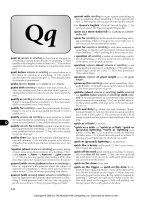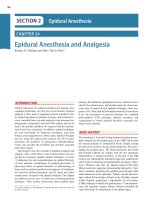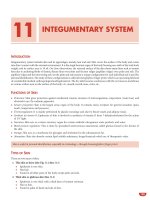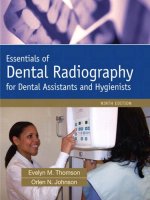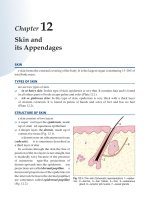Ebook Textbook of dental anatomy and oral physiology: Part 1
Bạn đang xem bản rút gọn của tài liệu. Xem và tải ngay bản đầy đủ của tài liệu tại đây (19.86 MB, 150 trang )
Textbook of Dental
Anatomy and Oral Physiology
Textbook of Dental
Anatomy and Oral Physiology
Including Occlusion and Forensic Odontology
Editor
Manjunatha BS BDS MDS (DNB)
Associate Professor
Department of Oral and Maxillofacial Pathology
KM Shah Dental College and Hospital
Vadodara, Gujarat, India
Forewords
C Bhasker Rao
GS Kumar
R Gowramma
JAYPEE BROTHERS MEDICAL PUBLISHERS (P) LTD
New Delhi • Panama City • London • Dhaka • Kathmandu
Jaypee Brothers Medical Publishers (P) Ltd
Headquarters
Jaypee Brothers Medical Publishers (P) Ltd
4838/24, Ansari Road, Daryaganj
New Delhi 110 002, India
Phone: +91-11-43574357
Fax: +91-11-43574314
Email:
Overseas Offices
J.P. Medical Ltd.
83 Victoria Street, London
SW1H 0HW (UK)
Phone: +44-2031708910
Fax: +02-03-0086180
Email:
Jaypee-Highlights Medical Publishers Inc.
City of Knowledge, Bld. 237, Clayton
Panama City, Panama
Phone: + 507-301-0496
Fax: + 507-301-0499
Email:
Jaypee Brothers Medical Publishers (P) Ltd
17/1-B Babar Road, Block-B, Shaymali
Mohammadpur, Dhaka-1207
Bangladesh
Mobile: +08801912003485
Email:
Jaypee Brothers Medical Publishers (P) Ltd
Shorakhute, Kathmandu
Nepal
Phone: +00977-9841528578
Email:
Website: www.jaypeebrothers.com
Website: www.jaypeedigital.com
© 2013, Jaypee Brothers Medical Publishers
All rights reserved. No part of this book may be reproduced in any form or by any means
without the prior permission of the publisher.
Inquiries for bulk sales may be solicited at:
This book has been published in good faith that the contents provided by the contributors
contained herein are original, and is intended for educational purposes only. While every
effort is made to ensure accuracy of information, the publisher and the editor specifically disclaim any damage, liability, or loss incurred, directly or indirectly, from the use or application
of any of the contents of this work. If not specifically stated, all figures and tables are courtesy
of the editor. Where appropriate, the readers should consult with a specialist or contact the
manufacturer of the drug or device.
Textbook of Dental Anatomy and Oral Physiology
Including Occlusion and Forensic Odontology
First Edition: 2013
ISBN : 978-93-5025-995-5
Printed at
Dedicated to
My
Great Teachers
Good Friends
Ever Loving Parents and Brothers
Aspiring Students
and
Two Angels, Chitti and Guddi
Ability is what you’re capable of doing.
Motivation determines what you do.
Attitude determines how well you do it.
Contributors
Ashith B Acharya BDS, GDFO (Australia)
Associate Professor and Head
Department of Forensic Odontology
SDM College of Dental Sciences
and Hospital
Dharwad, Karnataka, India
Nagarajappa Das MDS (DNB)
Associate Professor
Department of Oral and Maxillofacial
Surgery
SJM Dental College and Hospital
Chitradurga, Karnataka, India
Dharam Hinduja MDS
Associate Professor
Department of Conservative Dentistry
and Endodontics
Index Dental College and Hospital
Indore, Madhya Pradesh, India
Narayan Kulkarni MDS
Reader
Department of Orthodontics and
Dentofacial Orthopedics
KM Shah Dental College and Hospital
Vadodara, Gujarat, India
Gururaj B Patil MDS
Reader
Department of Oral and Maxillofacial
Pathology
Jodhpur Dental College and Hospital
Jodhpur, Rajasthan, India
Mallikarjuna M Rachappa MDS
Reader
Department of Pedodontics and
Preventive Dentistry
KM Shah Dental College and Hospital
Vadodara, Gujarat, India
Manjunatha BS BDS MDS (DNB)
Associate Professor
Department of Oral and
Maxillofacial Pathology
KM Shah Dental College and Hospital
Vadodara, Gujarat, India
Rajashekhara BS MDS
Assistant Professor
Department of Pedodontics and
Preventive Dentistry
College of Dental Sciences and
Hospital
Davangere, Karnataka, India
Ramesh Naykar MDS
Associate Professor
Department of Prosthodontics, Crown
and Bridge
KLE’s Institute of Dental Sciences and
Hospital
Belgaum, Karnataka, India
Foreword
Knowledge of Dental Anatomy and Tooth Morphology is a foundation for all
dental professionals and for the practice of dentistry. Its importance as a basic
science subject is highlighted by its inclusion in I BDS in the revised curriculum.
I am happy to note that Dr Manjunatha BS, an alumnus of SDM College of Dental
Science and Hospital, Dharwad, Karnataka, India is releasing this textbook, which
will be a useful addition to the subject.
The textbook covers all traditional aspects of tooth morphology and dental
occlusion; in addition, the book also includes a chapter which is a useful guide in
practical exercises such as tooth carving. New and development areas of dentistry
such as Forensic Odontology have also been covered from a dental anatomical
perspective. All of these should make this book an essential reference used by
dental student and graduate alike. I congratulate the author on his efforts, and
wish him the very best in the success of this textbook.
C Bhasker Rao MDS FDSRCPS (Glasgow)
Chief Mentor and Medical Director, Vasan Dental Hospitals Pvt Ltd, India
Formerly, Vice-President, Dental Council of India, New Delhi
Formerly, Principal and Director, SDM College of Dental Sciences and
Hospital, Dharwad, Karnataka, India
Foreword
Dental Anatomy and Oral Physiology are the foundations of dentistry on which
clinical dentistry rests. A textbook on these subjects should introduce the subject
in such a way that it makes the basic concepts clear, at the same time bringing out
the clinical relevance of the facts one has acquired. This theme has been followed
in this book admirably. For the beginner, the explanations of the terms used in
the introductory chapters is lucid so that the reader understands the details of the
subject matter easily in the later chapters. The language used is simple and the
illustrations aid in easy comprehension. The author’s passion for tooth carving
and his urge to reveal the ‘mysteries’ of tooth carving has found a place in this
book.
For the postgraduate students, the section on Tooth Anomaly would be useful.
Tooth Anatomy and Forensic Odontology is a novel idea and for those pursuing
a career in forensic dentistry, will find the information interesting. The clinician
will benefit, if he understands the concept of tooth form and function underlying
his preferred treatment options.
Dr Manjunatha BS is a determined person and he will not rest till the task
is completed. If he has to resolve a problem, he will go into great depths. As a
postgraduate guide, these are my impressions on the author. In fact, I have realized
his potential as a teacher and as a true academician, even when he was a postgraduate student. His experience in teaching and his interest in scientific pursuits,
his keenness to publish in scientific journals have now, made him done the role
of the author, which he has done creditably. I congratulate the contributors, who
have lent a helping hand in making of this book. It was indeed a pleasure to write
this foreword, and I am touched by the author’s gesture to give this honor to his
‘guru’.
GS Kumar MDS
Editor, Orban’s Oral Histology and Embryology
Professor and Head, Dean, KSR Institute of Dental Science and
Research Center, Tiruchengode, Tamil Nadu, India
Formerly, Professor and Head, Department of Oral Pathology
SDM College of Dental Sciences and Hospital
Dharwad, Karnataka, India
Foreword
I am delighted to write foreword for this much-needed Textbook of Dental Anatomy
and Oral Physiology, by Dr Manjunatha BS. He is known to me for the past 18
years as a student and faculty. I have found him academically oriented right from
the beginning of his career and same has culminated in writing this book.
Indeed, it is very interesting to know that there are very few textbooks on
Dental Anatomy written by an Indian author. Dr Manjunatha BS has made a
sincere attempt to script the textbook. The attention to minute details evident
in this book reflects the meticulousness and efficiency that is a quality found in
abundance in the author. He has included new chapters on Forensic Odontology
and Oral Physiology.
I am sure that owing to its umpteen illustrations, concise tables, simple
language and color photographs, this book is undeniably appropriate not only for
undergraduates but also for those pursuing graduate studies.
I congratulate the young author for all the efforts and hard work he has
undertaken.
R Gowramma MDS
Principal, Professor and Head
Department of Periodontics
SJM Dental College and Hospital
Chitradurga, Karnataka, India
Preface
This book is basically the result of more than eight years of my teaching in Dental
Anatomy and Oral Physiology for dental and medical students. Some of the
students have also been faculty and post-docs. I am very grateful to them for
their patience and tolerance as it progressed from crude notes to the present form.
Many of my teachers and friends have been a big source of inspiration and ideas.
It is my belief that Dental Anatomy and Oral Physiology have very much to
contribute to basic knowledge in the field of dentistry. I hope enough students
see this to make it happen. If this book contributes in any small way to the future
progress, it will serve its purpose.
The material in the book is written for persons at a number of levels. Much of
it is introductory for a beginner in dentistry, but serves to link to principles with
other branches by association. For that reason, it needs to be studied with some
care.
This list is incomplete and I wish to thank and acknowledge all those who were
involved with this. I owe a special note of thanks to so many colleagues who, for
various reasons, were (and many are still) skeptical of the approach. Without that
skepticism and close scrutiny, there would be far more weaknesses and errors in
this and related works. I hope this book provokes some strong reactions, positive
and negative.
No one is complete and perfect. Thus, I accept my limitations as well as short
comings in this book if any. I sincerely welcome all suggestions or any mistakes
and look forward to improve further.
Manjunatha BS
Acknowledgments
No one walks alone and when one is walking on the journey of life just where
you start to thank those that joined you, walked beside you and helped you along
the way.
First, I am extremely grateful to my teachers and would like to thank for all
that what I am in this field. I take this opportunity to express my reverence to Lord
“Shiva” with whose blessing I have been able to realize my dreams.
However, it would not have been possible without the kind support and help
of many individuals and organizations where I was associated. My sincere thanks
to all of them.
I also extend my heartfelt thanks to my parents, brothers and well-wishers
without whom this project would have been a distant reality.
My sincere gratitude to all the contributors who have put in a lot of efforts and
time in bringing out this book, without them it would have been like a tree in the
fall season.
Dr Narayan Kulkarni deserves special mention and thanks for his continuous,
untiring support and collaborative efforts to bring this book into the present form.
I am lucky to have good friends like Nagarajappa Das, Ashith B Acharya, Dharam
Hinduja, Basavaprabhu, Abdus, whose company I cherished, whose intellect and
science I admired, and steered me towards academics and research rather than purely
clinical practice.
I wish to sincerely thank professor GS Kumar, my mentor and guide, Dr R
Gowramma, my teacher for having given so much to all these important developments
in my profession. I would also like to thank my teacher, mentor and philosopher,
Dr C Bhasker Rao, Former Vice-President, Dental Council of India, New Delhi;
Former Principal, SDM College of Dental Sciences, Dharwad, Karnataka, India for
his encouragement and support.
I wish to thank and formally acknowledge the publishers for giving me an
opportunity. My heartfelt thanks to the staff of M/s Jaypee Brothers Medical
Publishers (P) Ltd, New Delhi, and Bengaluru Branch, for their patience and
continuous support. I kept them waiting much longer than I care to mention.
Last and not the most important, my special thanks to my dear wife Reshma
and the little angel Dhruti who were neglected in various ways during the arduous
hours required as I wrote these chapters to see that the book is completed. They
were inspirational that has driven me onwards and kept me focused.
Finally, I thank all who have helped me in their own ways even without me
realizing the worth of their efforts. My sincere thanks, love and respect to all of
them.
Finally, I acknowledge every person who in some way or the other has motivated
me and contributed towards accomplishing my objectives and dreams.
Contents
1.Introduction
Manjunatha BS, Dharam Hinduja
1
Functions of Teeth 2
Aims of Dental Anatomy 2
Objectives of Dental Anatomy 2
Scope of Dental Anatomy 2
Evolution of Teeth 3
Definitions 3
The Deciduous Dentition 3
The Permanent Dentition 4
Dental Formula 4
2. Definitions and Meaning of Terms Used in Dental Anatomy
Manjunatha BS, Dharam Hinduja
5
Terms 5
Parts of a Tooth 6
Structures (Tissues) of a Tooth 7
Surfaces of a Tooth 8
Terms Used in the Description of Morphology of a Tooth 10
Tooth Form and Function 20
Division of Tooth in Different Directions 21
Line and Point Angles of Different Teeth 22
3. Tooth Numbering Systems
Manjunatha BS
24
Zsigmondy/Palmer System 24
Universal System 26
FDI/Two Digit System 27
4. Development of Occlusion
Manjunatha BS, Narayan Kulkarni, Rajashekhara BS
Predentate Period 30
Deciduous Dentition 33
Mixed Dentition 38
Permanent Dentition 47
5. Permanent Incisors
Manjunatha BS
30
Functions of Incisors 49
Maxillary Incisors 50
Maxillary Central Incisor 50
Maxillary Lateral Incisor 57
Mandibular Incisors 62
Mandibular Central Incisor 62
Mandibular Lateral Incisor 66
49
xx Textbook of Dental Anatomy and Oral Physiology
6. Permanent Cuspids
Manjunatha BS
Functions of Canines 70
Class Traits [General Characters] of Canines 71
Maxillary Canines 72
Chronology of Permanent Maxillary Canine 73
Mandibular Cuspids 77
Chronology of Permanent Mandibular Canine 78
7.Premolars
Manjunatha BS
Manjunatha BS
103
Functions of Molars 103
Permanent Maxillary Molars 104
Permanent Maxillary First Molar 105
Chronology of Permanent Maxillary First Molar 106
Permanent Maxillary Second Molar 113
Chronology of Permanent Maxillary Second Molar 113
The Permanent Mandibular Molars 116
Permanent Mandibular First Molar 116
Chronology of Permanent Mandibular First Molar 116
Permanent Mandibular Second Molar 124
Chronology of Permanent Mandibular Second Molar 124
9. Deciduous Dentition
Manjunatha BS, Rajashekhara BS, Mallikarjuna M Rachappa
81
Functions of Premolars 81
Class Traits [General Characters] of Premolars 81
Maxillary First Premolar 82
Chronology of Permanent Maxillary First Premolar 83
Maxillary Second Premolar 87
Chronology of Permanent Maxillary Second Premolar 87
Permanent Mandibular Premolars 91
Permanent Mandibular First Premolar 91
Chronology of Mandibular First Premolar 92
Mandibular Second Premolar 96
Chronology of Mandibular Second Premolar 97
8. Permanent Molars
70
Maxillary Central Incisor 129
Maxillary Lateral Incisor 130
Maxillary Canine 131
Maxillary First Molar 132
Maxillary Second Molar 134
Mandibular Central Incisor 135
Mandibular Lateral Incisor 137
Mandibular Canine 137
Mandibular First Molar 138
Mandibular Second Molar 140
Differences Between Deciduous and Permanent Dentition 142
128
Contents xxi
10. Occlusion
Manjunatha BS, Narayan Kulkarni, Ramesh Naykar
146
Other Factors Associated with Occlusion 149
Dynamic Occlusion 154
Keys to Occlusion 155
Factors Affecting the Occlusion 158
Age Changes in Occlusion 159
Balanced Occlusion 159
11. Vascularity and Innervation of Maxilla and Mandible
Nagarajappa Das
161
Venous Drainage of Maxilla and Mandible 161
Nerve Supply to the Maxilla and Maxillary Teeth 161
Nerve Supply to the Mandible and Mandibular Teeth 165
12. Tooth Anatomy and Forensic Odontology
Ashith B Acharya
Definition of Metric Dental Traits 167
Definition of Non-metric Dental Traits 168
Sex Identification from Tooth Size 173
Race Identification from the Dentition 175
13. Carving Steps of Different Teeth
Gururaj B Patil
167
181
Carving of a Rectangle from Wax Block 181
Carving of a Cylinder from Wax Block 181
Carving of a Basic Model 182
Carving of Central Incisor 182
Carving Steps in Canine 186
Carving of Premolar 189
Carving of Molars 192
Carving of Mandibular Molar 195
14. Trait Features of Teeth
198
15. Calcium and Phosphorus Metabolism
204
Manjunatha BS
Manjunatha BS
Physiological Functions of Calcium 204
Distribution in the Body 205
Dietary Sources of Calcium 205
Calcium Absorption 206
Recommended Dietary Allowance 206
Calcium Balance 207
Calcium Homeostasis 207
Parathyroid Hormone 208
Calcitonin 210
Vitamin D 211
Effects of Other Hormones on Calcium Metabolism 212
Applied Physiology 212
Phosphate Metabolism 213
xxii Textbook of Dental Anatomy and Oral Physiology
16. Functions of Teeth
216
17. Pain
218
Manjunatha BS
Nagarajappa Das, Manjunatha BS
History 218
Components of Pain 218
Types of Pain 219
Theories of Pain 220
Distribution of Pain Receptors 222
Pathway of Pain in Orofacial Region 222
Dentinal Sensitivity and Pulpal Pain 222
Control of Pain 225
18. Saliva
Manjunatha BS
226
Composition of Saliva 226
Saliva Components 227
Properties of Saliva 228
Factors Influencing Salivary Flow and Composition 229
Functions of Saliva 230
Lubrication and Protection 230
Buffering Action 231
Antimicrobial Activity 231
Mechanical Cleansing Action 232
Taste 232
Digestion 232
Bolus Formation for Swallowing 233
Maintenance of Tooth Integrity 233
Miscellaneous Functions 234
The Diagnostic Applications of Saliva 234
Disadvantages/Limitations of Saliva 237
Index
239
Chapter
1
Introduction
Manjunatha BS, Dharam Hinduja
Dental anatomy is primarily concerned with the external form and appearance of
a tooth.
Definitions
It is the branch of dentistry which deals with gross structure, mainly the
morphology of the tooth and its associated parts.
It is the branch of dentistry which deals with the art and science of basic
morphological, anatomical and functional relationships of teeth, jaws and their
associated structures needed for normal harmony of an individual.
It is a branch of medicine and dentistry, which comprises of the study of
morphology of both tooth and its associated structures including masticatory
system.
Dental anatomy not only includes the study of tooth morphology, but also
involves roots, pulp chambers, crown contours, contacts and embrasures associated
with the crowns of teeth.
Tooth: Teeth are mineralized structures except for the pulp and are located in
first part of the digestive tract. A tooth is defined as “one of the hard tissues that
are positioned on the jaws and help in holding and mastication of food, also
as weapons of offense and defense in lower animals”. The designs of the teeth
are a reflection of eating habits. Teeth of a man are formed for cutting, tearing and
grinding of food substances.
Human dentitions are divided into many classes of teeth based on the appearance
and function or position. The types or different classes of teeth are as follows:
• Incisors: Incisors are named because they are used to incise or cut food. They
are located in the front part of the mouth and have sharp, thin edges for cutting
• Cuspids: Cuspids, also referred to as canines, are at the angles of the mouth.
Each tooth has a single cusp instead of an incisal edge and are designed for
cutting and tearing
• Bicuspids: Bicuspids, also referred to as premolars, are similar to the cuspids.
They have two cusps used for cutting and tearing, and an occlusal surface that
is wider to crush the food
• Molars: Molars are located in the back part of the mouth. Their size gradually
becomes smaller from the first to third molar. Each molar has four or five
cusps; these teeth are shorter and more blunt in shape than other teeth and
provide a broad surface for grinding and chewing solid masses of food.
The detailed description of each tooth is given in following chapters.
2 Textbook of Dental Anatomy and Oral Physiology
Functions of teeth
Human beings have teeth with rich and unique anatomic characteristics and thus
necessitate a comprehensive learning. The normal tooth form is extremely varied
with every individual and is very difficult to reproduce. The normal anatomy of
teeth assures the efficiency of mastication.
• Mastication is the primary function which includes cutting, shearing and chewing.
• Many others like growth of the skull and facial structures are seen with the
development of teeth.
• Deglutition and swallowing are done with the help of teeth.
• Phonation and aesthetics are other major functions of teeth (note these properties
in cleft lip/palate and edentulous patients).
• Protection to soft tissues of the mouth.
• Some animals, mainly carnivorous, use teeth for fighting and/or defense too.
It is very important for an animal to have teeth as they are used not only for
eating but also in grooming and defense.
• Last but not the least, tooth has a very important role in forensic odontology.
Each function of a tooth is described in respective chapters and in chapter 16,
page 217.
Aims of Dental Anatomy
• The dentist who is intended to care for teeth should have thorough knowledge
of the characteristics and fundamentals of dental morphology.
• To develop adequate manual skill to reproduce any part of the tooth, thus
maintaining the perfect correlation with associated structures.
• Of great importance, a knowledge of function and anatomy that is intimately
related to most dental areas.
Objectives of Dental Anatomy
The objectives of dental anatomy are as follows:• To know the normal anatomic, physiologic, and biomechanical relationships
of the dental structures.
• To be familiar with the clinical significance and define the shape and contour
relationships of the normal dentition.
• Identify, describe, and to reproduce in drawings and wax, the morphology of
permanent teeth from various views.
• Discuss the relationships between teeth and supporting structures.
• Correctly identify natural teeth with and without anatomical variations.
Scope of Dental Anatomy
Though currently the use of computers and computer assisted graphics have
helped out in teaching dental anatomy in three dimensional views, drawing and
dental carving are considered to be very practical and objective methods for
teaching and motivating dental students to obtain the knowledge till today.
The knowledge of dental anatomy is fundamental for the practice of any
branch of dentistry. Clinical/practical research and other activities in dental
